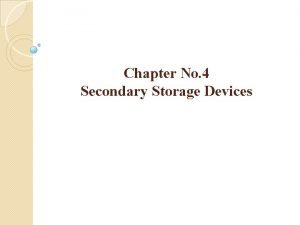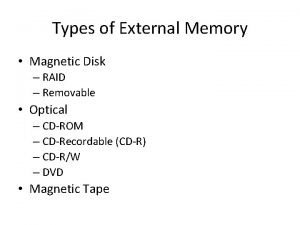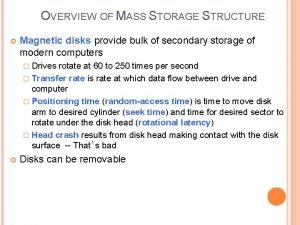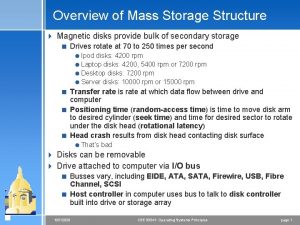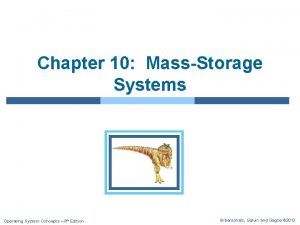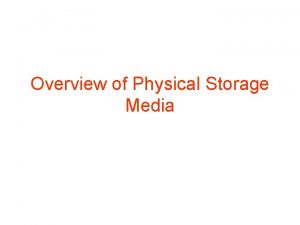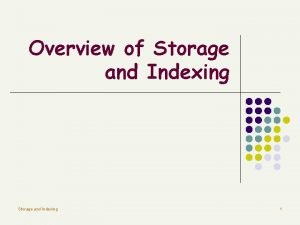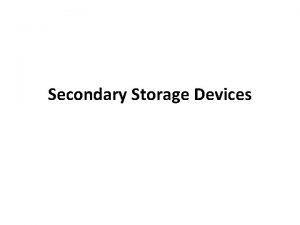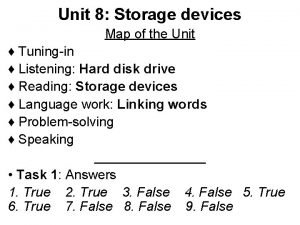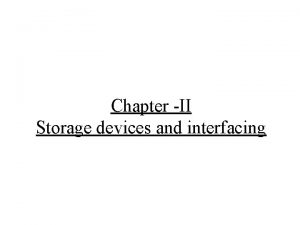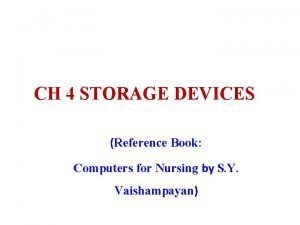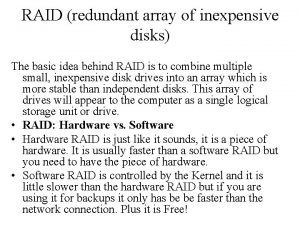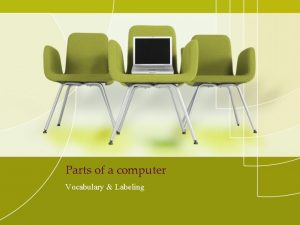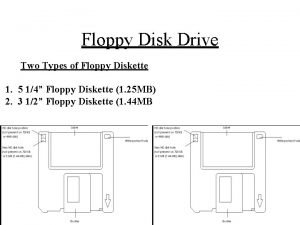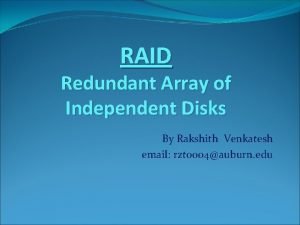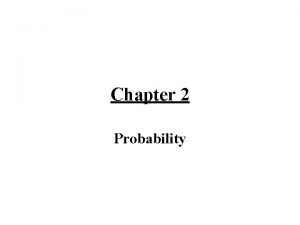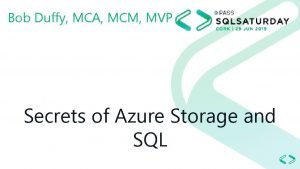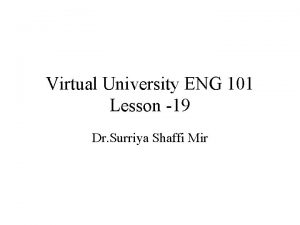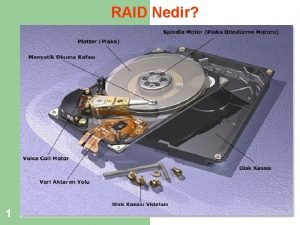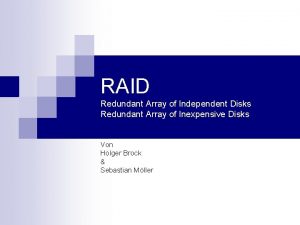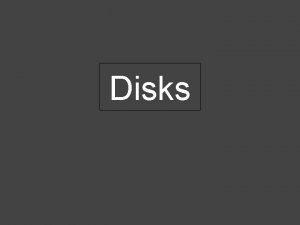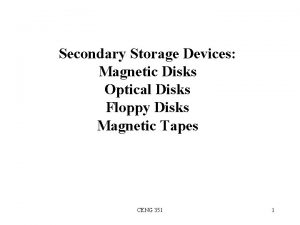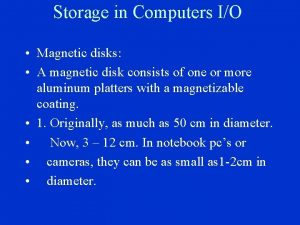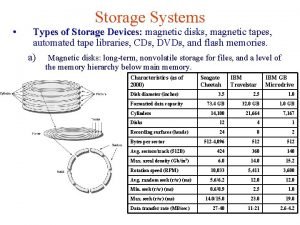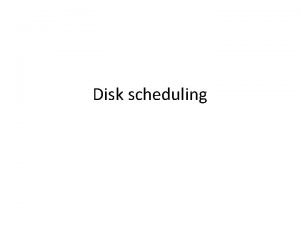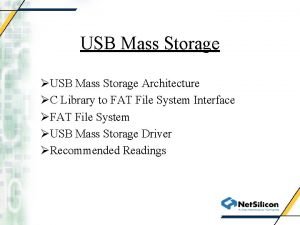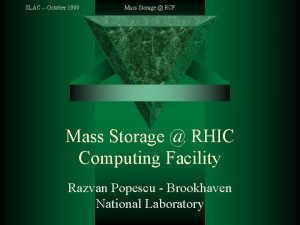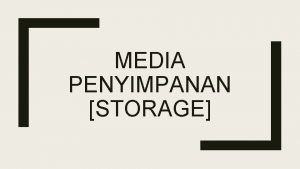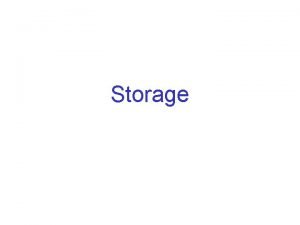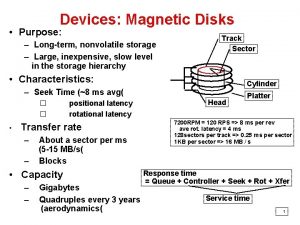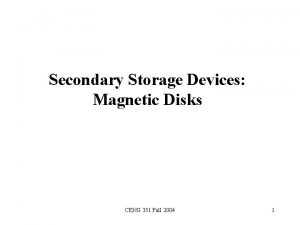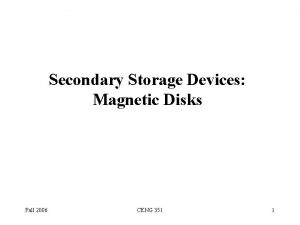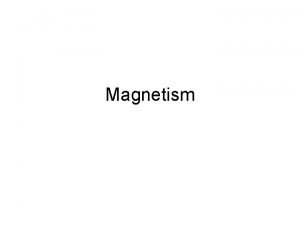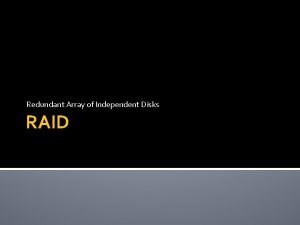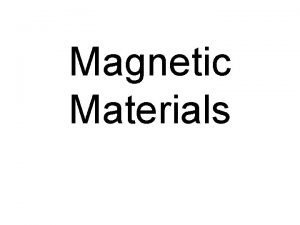Overview of Mass Storage Structure 4 Magnetic disks

























- Slides: 25

Overview of Mass Storage Structure 4 Magnetic disks provide bulk of secondary storage < Drives rotate at 70 to 250 times per second = Ipod disks: 4200 rpm = Laptop disks: 4200, 5400 rpm or 7200 rpm = Desktop disks: 7200 rpm = Server disks: 10000 rpm or 15000 rpm < Transfer rate is rate at which data flow between drive and computer < Positioning time (random-access time) is time to move disk arm to desired cylinder (seek time) and time for desired sector to rotate under the disk head (rotational latency) < Head crash results from disk head contacting disk surface = That’s bad 4 Disks can be removable 4 Drive attached to computer via I/O bus < Busses vary, including EIDE, ATA, SATA, Firewire, USB, Fibre Channel, SCSI < Host controller in computer uses bus to talk to disk controller built into drive or storage array 2/20/2021 CSE 30341: Operating Systems Principles page 1

Moving-head Disk Mechanism 2/20/2021 CSE 30341: Operating Systems Principles page 2

Disk drives Desktop disk Server disk 2/20/2021 CSE 30341: Operating Systems Principles page 3

Hard disk head, platter and disk crash 2/20/2021 CSE 30341: Operating Systems Principles page 4

Disk Structure 4 Disk drives are addressed as large 1 -dimensional arrays of logical blocks, where the logical block is the smallest unit of transfer. 4 The 1 -dimensional array of logical blocks is mapped into the sectors of the disk sequentially. < Sector 0 is the first sector of the first track on the outermost cylinder. < Mapping proceeds in order through that track, then the rest of the tracks in that cylinder, and then through the rest of the cylinders from outermost to innermost. 2/20/2021 CSE 30341: Operating Systems Principles page 5

Magnetic tape 4 Was early secondary-storage medium 4 Relatively permanent and holds large quantities of data 4 Access time slow 4 Random access ~1000 times slower than disk 4 Mainly used for backup, storage of infrequentlyused data, transfer medium between systems 4 Kept in spool and wound or rewound past readwrite head 4 Once data under head, transfer rates comparable to disk 4 20 -200 GB typical storage 4 Common technologies are 4 mm, 8 mm, 19 mm, LTO -2 and SDLT 2/20/2021 CSE 30341: Operating Systems Principles page 6

Tape pictures 2/20/2021 CSE 30341: Operating Systems Principles page 7

Tape Drives 4 The basic operations for a tape drive differ from those of a disk drive. 4 locate positions the tape to a specific logical block, not an entire track (corresponds to seek). 4 The read position operation returns the logical block number where the tape head is. 4 The space operation enables relative motion. 4 Tape drives are “append-only” devices; updating a block in the middle of the tape also effectively erases everything beyond that block. 4 An EOT mark is placed after a block that is written. 2/20/2021 CSE 30341: Operating Systems Principles page 8

Application Interface 4 Most OSs handle removable disks almost exactly like fixed disks — a new cartridge is formatted an empty file system is generated on the disk. 4 Tapes are presented as a raw storage medium, i. e. , and application does not open a file on the tape, it opens the whole tape drive as a raw device. 4 Usually the tape drive is reserved for the exclusive use of that application. 4 Since the OS does not provide file system services, the application must decide how to use the array of blocks. 4 Since every application makes up its own rules for how to organize a tape, a tape full of data can generally only be used by the program that created it. 2/20/2021 CSE 30341: Operating Systems Principles page 9

Tertiary Storage Devices 4 Low cost is the defining characteristic of tertiary storage. 4 Generally, tertiary storage is built using removable media 4 Common examples of removable media are floppy disks and CD-ROMs; other types are available. 2/20/2021 CSE 30341: Operating Systems Principles page 10

Removable Disks 4 Floppy disk — thin flexible disk coated with magnetic material, enclosed in a protective plastic case. < Most floppies hold about 1 MB; similar technology is used for removable disks that hold more than 1 GB. < Removable magnetic disks can be nearly as fast as hard disks, but they are at a greater risk of damage from exposure. 2/20/2021 CSE 30341: Operating Systems Principles page 11

Removable Disks (Cont. ) 4 A magneto-optic disk records data on a rigid platter coated with magnetic material. < Laser heat is used to amplify a large, weak magnetic field to record a bit. < Laser light is also used to read data (Kerr effect). < The magneto-optic head flies much farther from the disk surface than a magnetic disk head, and the magnetic material is covered with a protective layer of plastic or glass; resistant to head crashes. 4 Optical disks do not use magnetism; they employ special materials that are altered by laser light. 2/20/2021 CSE 30341: Operating Systems Principles page 12

WORM Disks 4 The data on read-write disks can be modified over and over. 4 WORM (“Write Once, Read Many Times”) disks can be written only once. 4 Thin aluminum film sandwiched between two glass or plastic platters. 4 To write a bit, the drive uses a laser light to burn a small hole through the aluminum; information can be destroyed by not altered. 4 Very durable and reliable. 4 Read Only disks, such ad CD-ROM and DVD, come from the factory with the data pre-recorded. 2/20/2021 CSE 30341: Operating Systems Principles page 13

Operating System Issues 4 Major OS jobs are to manage physical devices and to present a virtual machine abstraction to applications 4 For hard disks, the OS provides two abstraction: < Raw device – an array of data blocks. < File system – the OS queues and schedules the interleaved requests from several applications. 2/20/2021 CSE 30341: Operating Systems Principles page 14

File Naming 4 The issue of naming files on removable media is especially difficult when we want to write data on a removable cartridge on one computer, and then use the cartridge in another computer. 4 Contemporary OSs generally leave the name space problem unsolved for removable media, and depend on applications and users to figure out how to access and interpret the data. 4 Some kinds of removable media (e. g. , CDs) are so well standardized that all computers use them the same way. 2/20/2021 CSE 30341: Operating Systems Principles page 15

Speed 4 Two aspects of speed in tertiary storage are bandwidth and latency. 4 Bandwidth is measured in bytes per second. < Sustained bandwidth – average data rate during a large transfer; # of bytes/transfer time. Data rate when the data stream is actually flowing. < Effective bandwidth – average over the entire I/O time, including seek or locate, and cartridge switching. Drive’s overall data rate. 2/20/2021 CSE 30341: Operating Systems Principles page 16

Speed (Cont. ) 4 Access latency – amount of time needed to locate data. < Access time for a disk – move the arm to the selected cylinder and wait for the rotational latency; < 35 milliseconds. < Access on tape requires winding the tape reels until the selected block reaches the tape head; tens or hundreds of seconds. < Generally say that random access within a tape cartridge is about a thousand times slower than random access on disk. 4 The low cost of tertiary storage is a result of having many cheap cartridges share a few expensive drives. 4 A removable library is best devoted to the storage of infrequently used data, because the library can only satisfy a relatively small number of I/O requests per hour. 2/20/2021 CSE 30341: Operating Systems Principles page 17

Reliability 4 A fixed disk drive is likely to be more reliable than a removable disk or tape drive. 4 An optical cartridge is likely to be more reliable than a magnetic disk or tape. 4 A head crash in a fixed hard disk generally destroys the data, whereas the failure of a tape drive or optical disk drive often leaves the data cartridge unharmed. 2/20/2021 CSE 30341: Operating Systems Principles page 18

Cost 4 Main memory is much more expensive than disk storage 4 The cost per megabyte of hard disk storage is competitive with magnetic tape if only one tape is used per drive. 4 The cheapest tape drives and the cheapest disk drives have had about the same storage capacity over the years. 4 Tertiary storage gives a cost savings only when the number of cartridges is considerably larger than the number of drives. 2/20/2021 CSE 30341: Operating Systems Principles page 19

Price per Megabyte of DRAM, From 1981 to 2004 2/20/2021 CSE 30341: Operating Systems Principles page 20

Price per Megabyte of Magnetic Hard Disk, From 1981 to 2004 2/20/2021 CSE 30341: Operating Systems Principles page 21

Price per Megabyte of a Tape Drive, From 1984 -2000 2/20/2021 CSE 30341: Operating Systems Principles page 22

Network-Attached Storage 4 Network-attached storage (NAS) is storage made available over a network rather than over a local connection (such as a bus) 4 NFS and CIFS are common protocols 4 Implemented via remote procedure calls (RPCs) between host and storage 4 New i. SCSI protocol uses IP network to carry the SCSI protocol 2/20/2021 CSE 30341: Operating Systems Principles page 23

Storage Area Network 4 Common in large storage environments (and becoming more common) 4 Multiple hosts attached to multiple storage arrays flexible 2/20/2021 CSE 30341: Operating Systems Principles page 24

Hierarchical Storage Management (HSM) 4 A hierarchical storage system extends the storage hierarchy beyond primary memory and secondary storage to incorporate tertiary storage — usually implemented as a jukebox of tapes or removable disks. 4 Usually incorporate tertiary storage by extending the file system. < Small and frequently used files remain on disk. < Large, old, inactive files are archived to the jukebox. 4 HSM is usually found in supercomputing centers and other large installations that have enormous volumes of data. 2/20/2021 CSE 30341: Operating Systems Principles page 25
 Magnetic disks are the most popular medium for
Magnetic disks are the most popular medium for Types of magnetic disks
Types of magnetic disks Moving head disk mechanism
Moving head disk mechanism Mass storage structure
Mass storage structure Secondary storage structure
Secondary storage structure Mass storage structure in operating system
Mass storage structure in operating system Types of ferrites
Types of ferrites Magnetic field unit in weber
Magnetic field unit in weber Magnetic moment and magnetic field relation
Magnetic moment and magnetic field relation Force on charged particle
Force on charged particle Types of physical storage media
Types of physical storage media Overview of storage and indexing
Overview of storage and indexing Magnetic tape in secondary memory
Magnetic tape in secondary memory Unit 10 magnetic storage
Unit 10 magnetic storage Magnetic storage
Magnetic storage 4 storage devices of computer
4 storage devices of computer Tower of hanoi 4 disks
Tower of hanoi 4 disks Redundant array of inexpensive disks
Redundant array of inexpensive disks A computer that serves one user at a time
A computer that serves one user at a time Types of floppy disk
Types of floppy disk Redundant arrays of independent disks
Redundant arrays of independent disks Probability learning objectives
Probability learning objectives Azure vm ssd
Azure vm ssd Disks and tapes can be stored ------- a library. eng101
Disks and tapes can be stored ------- a library. eng101 Unraid nedir
Unraid nedir Redundant array of independent disks
Redundant array of independent disks
